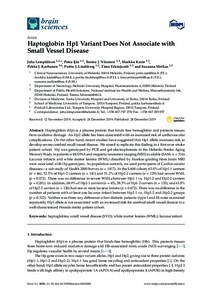Haptoglobin Hp1 Variant Does Not Associate with Small Vessel Disease
Melkas S; Lindsberg PJ; Karhunen PJ; Lempiäinen J; Ijäs P; Erkinjuntti T; Kaste M; Niiranen TJ
Haptoglobin Hp1 Variant Does Not Associate with Small Vessel Disease
Melkas S
Lindsberg PJ
Karhunen PJ
Lempiäinen J
Ijäs P
Erkinjuntti T
Kaste M
Niiranen TJ
MDPI
Julkaisun pysyvä osoite on:
https://urn.fi/URN:NBN:fi-fe2021042824815
https://urn.fi/URN:NBN:fi-fe2021042824815
Tiivistelmä
Haptoglobin (Hp) is a plasma protein that binds free hemoglobin and protects tissues from oxidative damage. An Hp2 allele has been associated with an increased risk of cardiovascular complications. On the other hand, recent studies have suggested that Hp1 allele increases risk to develop severe cerebral small vessel disease. We aimed to replicate this finding in a first-ever stroke patient cohort. Hp was genotyped by PCR and gel electrophoresis in the Helsinki Stroke Aging Memory Study in patients with DNA and magnetic resonance imaging (MRI) available (SAM; n = 316). Lacunar infarcts and white matter lesions (WML) classified by Fazekas grading from brain MRI were associated with Hp genotypes. As population controls, we used participants of Cardiovascular diseases-a sub study of Health 2000 Survey (n = 1417). In the SAM cohort, 63.0% of Hp1-1 carriers (n = 46), 52.5% of Hp1-2 carriers (n = 141) and 51.2% of Hp2-2 carriers (n = 129) had severe WML (p = 0.372). There was no difference in severe WMLs between Hp1-1 vs. Hp1-2 and Hp2-2 carriers (p = 0.201). In addition, 68.9% of Hp1-1 carriers (n = 45), 58.5% of Hp1-2 carriers (n = 135), and 61.8% of Hp2-2 carriers (n = 126) had one or more lacunar lesions (p = 0.472). There was no difference in the number of patients with at least one lacunar infarct between Hp1-1 vs. Hp1-2 and Hp2-2 groups (p = 0.322). Neither was there any difference when diabetic patients (type I and II) were examined separately. Hp1 allele is not associated with an increased risk for cerebral small vessel disease in a well-characterized Finnish stroke patient cohort.
Kokoelmat
- Rinnakkaistallenteet [19207]
